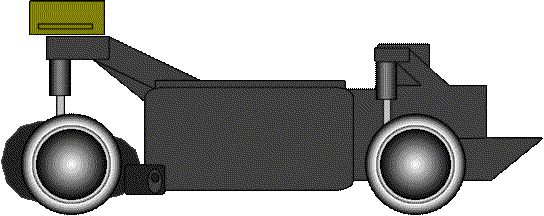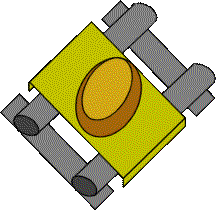
| Home |
| Weather |
| Energy |
| BioGeoChem |
| Landfill |
| EcoSystems |
| Genetics |
| >Vehical |
To: Motor Vehicle Corporation I am a student at Rivendell high school and wish to submit an idea for review. We have been studying forces and motion on the premise of vehicular safety in our science class. Adam Stuart, and I (Ape-Iñago), has elected the task of designing a new seatbelt system. To our understanding, seatbelts work on the basic equation of F=ma (Force = Mass x Accelleration). The idea is that since acceleration is a factor of the change in distance / change in time, if we change the time, it will decrease the force (see http://science.howstuffworks.com/fpte.htm). So essentially, the more time the seatbelt takes to slow you down, lower the acceleration will be. Since we are redesigning the whole seatbelt, we wanted to focus on not only the amount of force it creates, but also the comfort of the passengers. Seatbelts as they are work fine, but we wanted to go with a different idea altogether; by placing the “belt” onto a movable frame, all the passengers can be hooked in with another seatbelt or even strapped in with more solid device to distribute the force evenly. This design works great with the newer Hydrogen Fuel-cell Cars that have their engine near the wheels, since it leaves ample room for the seat to move forward and backward (perhaps an ejection luggage compartment in the back would help aswell). We believe that having the belt hooked to a moveable seat, it will allow the belt to be longer and thus make a bigger time of deceleration and in the end less force on the passenger. Also, having the car in a neutral position between two belts will also help stop the whiplash effects since it will also bound backwards in the same way (although it will need a system to prevent it from moving if its not in a crash). We have decided to test our theory on an egg in a seating system set upon a Remote Control Car. In our tests, we will be looking for a few variables that will effects the system. The first being the speed of the car, because that will allow for the calculation of the deceleration when hitting the wall. The next variable is the weight of the entire system; more weight means a much higher impact force. Another factor might be the “stretchiness” of the rubber band (a substitute belt). And finally we’ll need to actually calculate the force, and see how much it requires to break the egg. I’ll explain how we measured these after I describe the actual system: We took an old remote control car (a red pt cruiser) and striped it down to it’s bear essence. The front-end was chopped down for weight. (for more speed). The rear axel was locked so it doesn’t spin out. (Drives in straight line from start). We lengthened back springs so it has more consistent traction. (More speed at take off). Placed 2x200gm weights over back spring, with hot glue. (More speed/straight line). Placed 3 eyehooks on each side so we can thread with fishing line. (Follows straight line). The seat was attached to the top of the car using some twisted metal wires. The seat was an ingenious design by my classmate Adam Stuart. It was made out of what he describes as cauterized steel. Using a pair of steel tubes and two steel slabs, he made a track. On this track slides a custom molded seat for the egg made out of “body putty”, since it was the strongest material we could find to mold. The hollow tubes contain a swivel like system that makes a pin drop out of the sliding seat when the car hits the wall (as mentioned before, we don’t want it swaying back and forth when not in an impact). The car will be driven down a pair of taught fishing lines into a solid wall. There is a piece of wood duct-taped to the wall at the appropriate height so the collision will cause the metal rods to move down the tube. These rods will make the dime spin and pull the pin out of the seat. The removal of the pin allows the seat to move forward and get the effects of the rubber band. Reference the following diagram: THE CAR:
The Seat:
We calculated the speed by driving the car down the 10-meter stretch of fishing line, and timed how long it took. It hit the end of the line in 5.7077 seconds, so it had a speed of 1.752019202 meters /second. The weight was a little tricky to get because the entire vehicle was too heavy for an individual scale to measure, but we balanced the car between 4 scales and then added them up, it weighed a total of 1.64909kg including the battery which we weight separately. The stretch ability of the rubber band we found using a simple method; we hung a 200g weight on the end of a 2inch section, it stretched 2cm from its original position. At 400g on the same rubber band, it stretched 4cm. And since gravity is a constant, you can figure how much force was placed on the rubber band to stretch it that far. Finally, the total force placed on the egg is equivalent to 50g * 1.752019202m/s, for a total of 0.0876009601g/m/s (Newtons). After it was all set up, we proceeded to test our design with hard boiled eggs. We did 21 runs, 11 with the safety system enabled, and 10 with the seat immobile (we wedged the pin in so it wouldn’t come out). Each run was done with the egg correctly positioned in the seat and at the same distance from the wall (we had marked it on the floor). For the 10 runs with the system engaged, the seat moves forward a significant distance upon impact, and there is very little done to the egg. There was a crack in the first of the test eggs, but that was because we jammed it the seat a little too hard, so we discarded those results from the safety system tests. The 10 runs without the safety system were a totally different story. With the exception of one run, the egg would always fly out of the seat and hit with the wall, so they all had quite significant dents on the top of the shells. Also the part of the egg that was in contact with the seat had a clear impact line coinciding with the location of the seat’s ledge. The system works, and is very effective. I’d venture to say that it would be a much better way to have a belt in a car. It could be designed relatively small, perhaps even placed in the area below a car’s doors, and hooked onto the side of a thin mobile floor. It alone would be as much, if not more effective then an ordinary seat belt, since it allows for a much longer release of the force from a collision. Please Email Ape-Iñago (Ultimape@hotmail.com) with any responses
to this design, I’d be willing to answer questions. (and it
would make us feel proud to know its been looked at). |
| All information and/or images have been copyrighted 2003© 'Ultim'Ape-Iñago or by it's respective owner, they are not to be reproduced without written consent of creator, with the exception of quoted and sourced text for a site review or factual support. |

